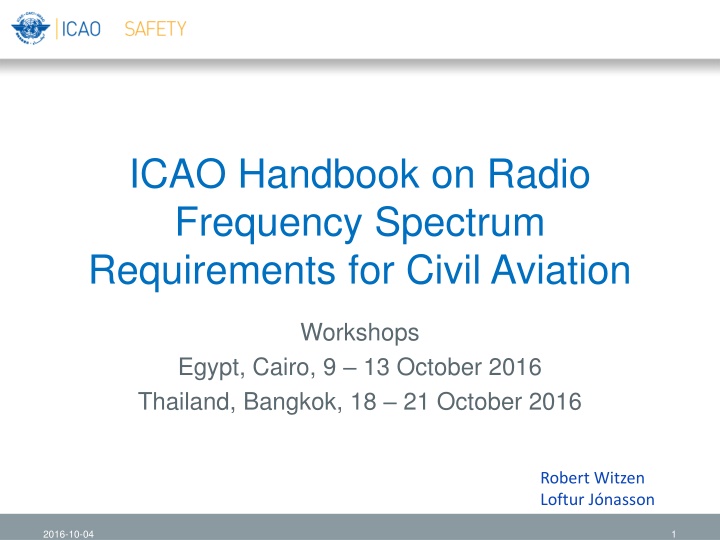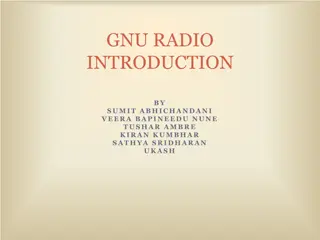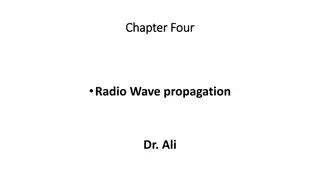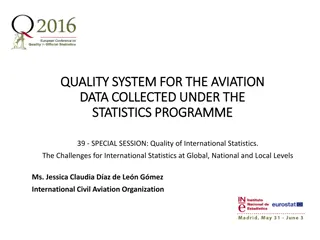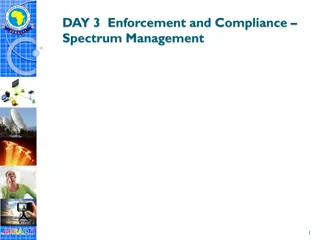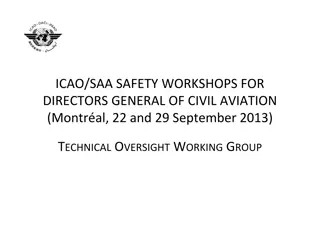ICAO Handbook on Radio Frequency Spectrum Requirements for Civil Aviation Workshops
This handbook provides insights into spectrum requirements for civil aviation workshops conducted in Egypt and Thailand in October 2016. It covers spectrum strategy, frequency management, spectrum overview for aviation, and frequency assignment planning to support the application of SARPs in Annex 10, Vol. V. Developed in conjunction with revisions to Annex 10, the handbook aims to guide global and regional frequency assignment planning for air navigation.
Download Presentation

Please find below an Image/Link to download the presentation.
The content on the website is provided AS IS for your information and personal use only. It may not be sold, licensed, or shared on other websites without obtaining consent from the author.If you encounter any issues during the download, it is possible that the publisher has removed the file from their server.
You are allowed to download the files provided on this website for personal or commercial use, subject to the condition that they are used lawfully. All files are the property of their respective owners.
The content on the website is provided AS IS for your information and personal use only. It may not be sold, licensed, or shared on other websites without obtaining consent from the author.
E N D
Presentation Transcript
ICAO Handbook on Radio Frequency Spectrum Requirements for Civil Aviation Workshops Egypt, Cairo, 9 13 October 2016 Thailand, Bangkok, 18 21 October 2016 Robert Witzen Loftur J nasson 2016-10-04 1
Introduction Volume I + Spectrum Management Spectrum strategy - Provides for the long term of current and future spectrum usage of radio systems ICAO policies on use of aeronautical spectrum to support the ICAO spectrum strategic objectives ICAO position for future ITU WRC . Volume II + Frequency Management ICAO Frequency Assignment Planning 2016-10-04 2
Vol. I Vol. I Overview of spectrum for aviation Overview of spectrum for aviation 100 MHz 20 MHz 30 MHz 40 MHz 60 MHz 80 MHz 100 kHz 200 kHz 300 kHz 400 kHz 600 kHz 800 kHz 10 MHz 2 MHz 3 MHz 4 MHz 6 MHz 8 MHz 1 MHz LF band (#5) MF band (#6) HF band (#7) VHF band (#8) 300 m 100 m 30 m 10 m 3 km 1 km 3 m HF Air/ground voice / data Air/ground communications Marker beacons NDB / Locator beacons Navigation Frequency range 100 kHz 100 MHz 2000 MHz 3000 MHz 4000 MHz 6000 MHz 8000 MHz 1000 MHz 100 MHz 200 MHz 300 MHz 400 MHz 600 MHz 800 MHz 100 GHz 20 GHz 30 GHz 40 GHz 60 GHz 80 GHz 10 GHz VHF band (#8) UHF band (#9) SHF band (#10) EHF band (#11) 30 cm 10 cm 3 mm 3 km 3 cm 1 cm 1 m L S C X Ku K Ka Former band letters EPIRB / ELT Satellite communications MTSAT and Inmarsat AeroMACS UAS terrestrial UAS satellite Iridium LDACS Air/ground voice / data Air/ground communications Localizer / VOR/GBAS DME MLS Glide path Navigation L1 Airborne Doppler radar L5 GNSS Airborne radar SSR Surveillance PSR PSR Radio Altimeter Airborne weather radar ASDE radar Frequency range 100 MHz 100 GHz Notes: Drawing not to scale Not all Regional or sub-Regional allocations are shown Band identification (e.g. VHF) and band # per Radio Regulations The satellite communication bands used by MTSAT and Inmarsat are not allocated the the Aeronautical Mobile Satellte (R) Service 2016-10-04 3
Vol. II Vol. II Frequency assignment planning Frequency assignment planning Provides for globally harmonized frequency assignment planning criteria and guidance material to support the application of SARPs in Annex 10, Vol. V Developed in conjunction with the revisions to Annex 10, Vol. V Developed by the frequency Spectrum Management Panel (FMSP) Implementation has been agreed through the relevant Regional eANP Support the development of a frequency assignment plan which encompasses Global and Regional COM lists and the Global Air Navigation Plan 2016-10-04 4
Vol. II Vol. II Frequency assignment planning Frequency assignment planning Chapter 1 Chapter 1 General methodology (1) General methodology (1) General methodology for compatibility analysis General model for compatibility assessment Based on: Protection of desired signal at receiver input Not to exceed maximum permissible distortion of receiver output signal receiver input RPd antenna input Pd e.i.r.p D Feeder loss Antenna gain Propagation loss Antenna gain Feeder loss Transmitter Receiver PTd Fd Gd Ld Gr Fr PTr antenna input Pu receiver input RPu Feeder loss Antenna gain Propagation loss Transmitter PTu Fu Gu Lu e.i.r.p U 2016-10-04 5
Vol. II Vol. II Frequency assignment planning Frequency assignment planning Chapter 1 Chapter 1 General methodology (2) General methodology (2) receiver input RPd antenna input Pd e.i.r.p D Feeder loss Antenna gain Propagation loss Antenna gain Feeder loss Transmitter Receiver PTd Fd Gd Ld Gr Fr PTr antenna input Pu receiver input RPu Feeder loss Antenna gain Propagation loss Transmitter PTu Fu Gu Lu e.i.r.p U Determine the desired signal level at receiver input Determine the undesired signal level at receiver input Determine the D/U ratio If PD and PU are the same, D/U is LD -LU 2016-10-04 6
Vol. II Vol. II Frequency assignment planning Frequency assignment planning Radio wave Propagation model Radio wave Propagation model Propagation model Based on free space propagation (Re. Recommendation ITU-R P.525) Propagation model does not accommodate certain phenomena which are difficult to predict such as Changes in the refractive index of the atmosphere Ducting ITU has developed propagation curves for aeronautical communication and navigation systems (Recommendation ITU-R P.528) 2016-10-04 7
Vol. II Vol. II Frequency assignment planning Frequency assignment planning Compatibility criteria for frequency coordination (1) Compatibility criteria for frequency coordination (1) Frequency assignment planning criteria are to be considered as a generic technical measure to support frequency coordination. Planning criteria provide for a rather conservative method to assign frequencies without causing harmful interference. In most cases, a detailed technical analysis may result in reduced geographical separation being required. Consideration of actual operational use 2016-10-04 8
Vol. II Vol. II Frequency assignment planning Frequency assignment planning Compatibility criteria for frequency coordination (2) Compatibility criteria for frequency coordination (2) Frequency assignment plans may include frequency assignments which do not meet the planning criteria as agreed by ICAO In many of such cases these frequency assignments may be considered operationallycompatible consideration of the operational use absence of interference reports consideration of the effect of the terrain. as result of a detailed analysis of the technical characteristics of both the desired and undesired stations Non-compatible identification in Frequency Finder does not necessarily imply operational incompatibility 2016-10-04 9
Vol. II Vol. II Frequency assignment planning Frequency assignment planning Compatibility criteria for frequency coordination (3) Compatibility criteria for frequency coordination (3) A station that is considered Not Compatible because it does not meet the ICAO frequency assignment planning criteria is not, by default, also operationally Not Compatible . Frequency Finder displays geographical areas where interference is predicted to support a more detailed analysis. 2016-10-04 10
